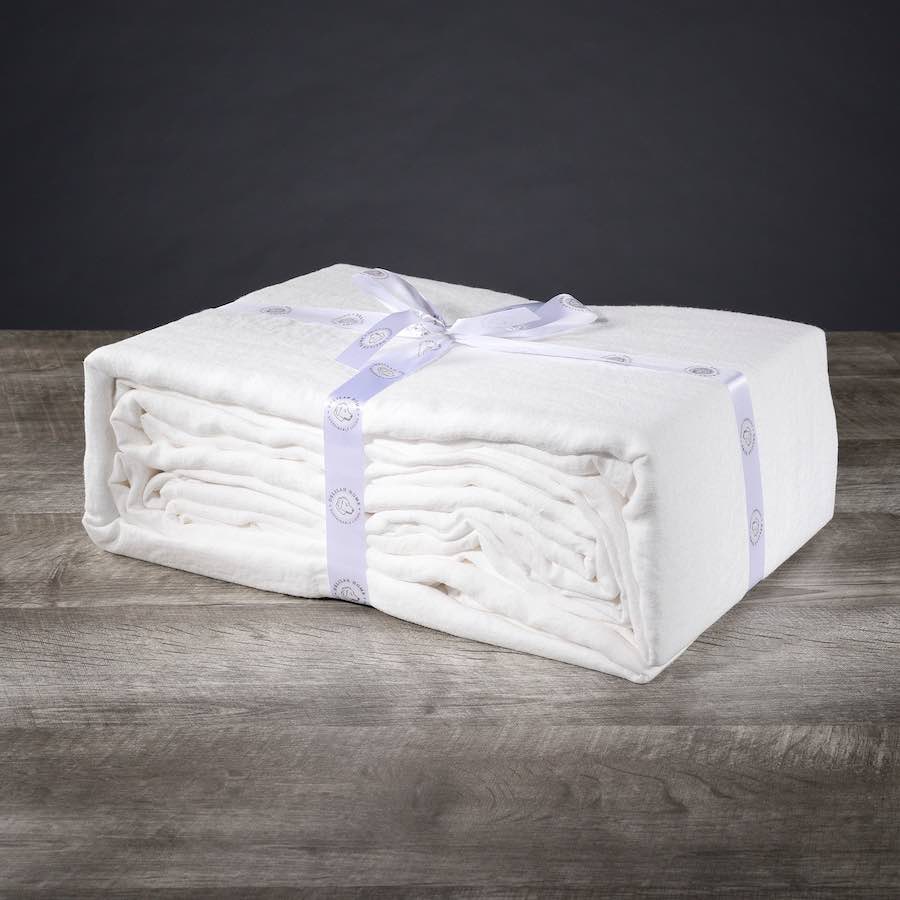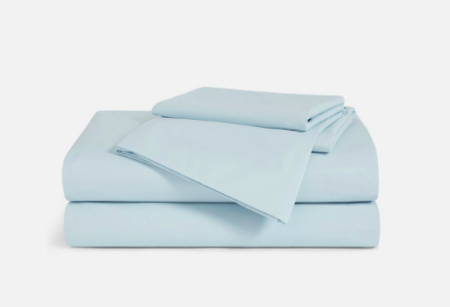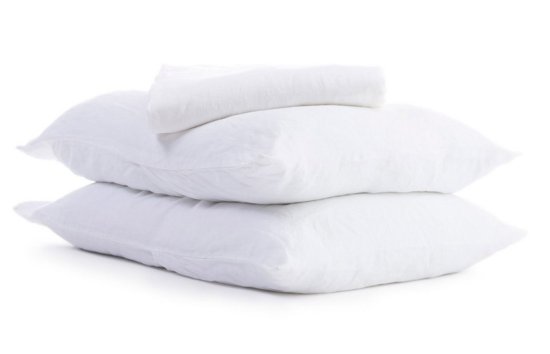Buying Guide – How to Choose the Best Cooling Sheets
Cooling sheets are an ideal purchase for anyone who wants to enjoy a good night’s sleep despite warm temperatures. They’re popular with people who live in warm climates all year. If you endure “night sweats,” cooling sheets are also ideal, as the material tends to absorb sweat and dry quickly. Some cool sheets can even perform double duty, cooling you in the summer and helping you to stay warm during the frigid winter months.
This guide will help explain the nature of cooling sheets, provide tips for selecting the right set of sheets, and offer recommendations based on customer reviews and experiences.
Why Buy Cooling Sheets?
There are a variety of benefits to owning cooling sheets, although needs may change depending on the sleeper. For instance, some may buy sheets that keep them cool strictly for use during the hottest months of the year. Others who experience night sweats year-round may appreciate their absorption and cooling abilities. No matter who you are, cooling sheets will help you stay cool and dry through the night.
Overall, cooling sheets are typically useful for:
- Living in warmer climates where temperatures tend to be high all year long.
- Avoiding the sensation of feeling overheated that comes with thicker, more massive bedding.
- Absorbing perspiration so that sleepers stay as dry as possible.
- Cutting energy costs by allowing homeowners to avoid adjusting the thermostat or turning on fans.
- Keeping warm during the winter months, as some fabrics are both cooling and warming.
- Helping the environment.
- Allowing sleepers to get a full night’s sleep. They may be less prone to waking up during the night as feeling hot and uncomfortable won’t be an issue.
Thread count and material preferences can change from person to person, but those who own these sheets agree the cooling and absorption abilities make them a worthwhile purchase.
Rise in Popularity
The more consumers learn about the positive benefits of sheets that keep you cool, the more these sheets increase in popularity. It’s also worth noting that as people become more environmentally conscious, they’re steadily focusing on decision-making that reduces wastefulness. That extends to their purchasing behaviors.
Cooling sheets are usually made using natural, long-lasting materials. That makes them a practical solution for coping with hot temperatures and sticky perspiration. Additionally, the comfortableness of the sheets can help you get a good night’s sleep, letting you feel more energized in the morning.
Even when shopping for the right best cooling sheets, the reasons for choosing one set over another may vary. It’s not just about comfort; it might be about improving your health, helping the environment, or cutting costs.
Whatever your cooling sheet needs, it’s best to do proper research and be honest about your needs when looking to make the right type of cooling sheet purchase.
The Importance of Thread Count
Before buying cooling sheets, you’ll want to consider your preferred thread count, otherwise known as the number of horizontal and vertical threads per square inch. When it comes to buying sheets, it’s the thread count that’s often one of the first considerations.
- The right thread count range translates to softer sheets.
- It affects the strength and durability of the fabric.
- Fabrics with a higher thread count may last longer and wear more evenly.
- Those who buy sheets with a higher thread count tend to associate them with a feeling of luxury and comfort.
That said, it’s necessary to be careful when shopping for sheets with a higher thread count. Some manufacturers mislead customers about their product’s thread count number. The company might use low-quality threads in high volume, which makes the thread count meaningless as you’re getting a poorly made product.
Stick to a reasonable thread count range to ensure not only quality but that your money is well spent. Depending on your needs, a good thread count for sheets may range from 250 to 400. In truth, it’s rare to find a genuine thread count above 400 because there’s only so much thread that can fit into a square inch of space. Be cautious when buying sheets boasting more than this number.
Sheets above a certain thread count number tend to be heavier and less breathable. It may also take a few washes for them to soften up. For shoppers seeking sheets that are immediately cooling and comfortable, it’s best to stick to 300-count sheets.
Important Considerations
Cooling sheets aren’t a one-time thing; before buying, there are certain considerations you’ll need to make. Below you’ll find information to help you more easily decide what set of sheets is perfect for you.
Materials
Cooling sheets are typically made from one of several types of material. Below you’ll learn a bit about the advantages of each type.
- Cotton: Of the types of cotton most commonly used for bed sheets, Egyptian is the most popular choice; it’s the finest and softest kind of cotton. Egyptian can be cooling or warming depending on the thread count and style of weaving. Fabric made from Egyptian cotton tends to be highly breathable and absorbing.
- Linen: It’s often the material of choice for cooling sheets among those living in warmer climates. Not only is linen cooler than cotton, but high-quality sheets can last for decades.
- Silk: Although manufacturers are quick to tote silk’s absorbent quality as good for those who suffer night sweats, it’s not exactly known for its cooling properties. Silk is tricky in that it’s cool to the touch at first, but instead of maintaining this sensation, the fabric traps and holds onto heat. It’s actually why silk is preferred when making warming sheets.
- Bamboo: As consumers become more environmentally conscious, bamboo increases in popularity. Not only is the material eco-friendly, but it’s also hypoallergenic, breathable, highly durable, and gentle to the touch. Bamboo fabric is typically much cooler than cotton.
- Microfiber: Synthetic fibers aren’t necessarily the first choice for cooling sheets. Although the material is stretchy, it can leave sleepers feeling sticky and damp due to excessive sweating.
- Tencel: Typically made using rayon or lyocell materials. It’s a recyclable, eco-friendly fabric. It bears a resemblance to silk while being more breathable and moisture absorbing.
Thread Count
Not all sheets work for cooling purposes, and thread count is a big part of the reason why. Ideally, a thread count range of 250 to 300 works for cooling sheets, and you don’t want to exceed a 500 count.
Different materials work best at different thread counts, which is why you’ll often find a recommended range for cooling sheets rather than a fixed thread count number. It’s also crucial to note that a high thread count means nothing if the sheets are made from low-quality fibers. A high-quality fiber can be very cooling even with a low thread count.
Weave
Weaving, or how sheets are stitched, can affect the breathability and texture of a fabric. It also impacts the ability to retain moisture and heat. Certain weaves are more ideal for cooling sheets.
- Percale – A flat, simplistic style of weaving cotton fabrics. The style was originally used on house dresses and aprons. Percale is known for its crisp matte finish. Percale-weave fabrics are lightweight, breathable, and unlikely to pill. It’s an ideal method for cooler sheets.
- Sateen – It’s similar in appearance to satin due to the weaving style but sateen fabric comes from cotton and satin-weaved sheets are made from silk. It’s a heavier weave than percale, but still cool to the touch.
- Satin – These sheets are to summer what silk is to winter. A very shiny, luxurious feeling material that is cooling.
- Jersey – A versatile fabric pattern, allowing sheets to stay cool in the summer and warm in the winter.
Cleaning Your Sheets
For the sake of modern convenience, most cooling sheets are machine washable. Even so, it’s important to pay attention to any special instructions. It’s common for these sheets to be cold wash only. As for drying, a low, gentle machine setting is best. Some materials may be bleachable, but others are not. Check carefully to avoid ruining your sheets.
Always read the labels to determine how best to clean your sheets. If the instructions aren’t clear, go to the manufacturer’s website or possibly reach out for more information.
Why You Should Buy Neutral Colors
When shopping for the best cooling sheets for your bed, you’ll likely notice that most sets are available in neutral colors. While it’s possible to seek out brightly colored and patterned sheets, it’s probably not a great long-term investment.
Neutrally colored sheets are preferred because of their ability to complement a wide variety of other bedding items. Additionally, it’s possible that patterns popular today could fall out of fashion. There’s no point in spending money on bedding that you’ll grow tired of looking at.
Neutral colors are also more soothing than some colors. Bright red, for instance, is scientifically proven to elevate the heart rate. It’s a color for those wide-awake rather than sleeping.
Additional Considerations
There are a few other considerations for buyers in the market for new cooling sheets. Specifically, what companies mean when they brand their sheets as natural or organic. It’s also important to take into consideration the possibility of returning any cooling sheet sets that you weren’t pleased with.
Natural and Organic Materials
Natural: Materials that come from the natural environment and have experienced almost no modification.
Organic: Made with relatively little or no synthetic materials, pesticides, or fertilizers.
Products that are truly organic or all natural tend to cost more because greater care is taken in the process to avoid relying on man-made, synthetic materials. You should always check to make sure your purchase is certified to be 100 percent natural or organic. Some companies will tote a “natural” label, but upon further research, it turns out that the sheets are only made of 40 percent natural or organic materials.
Return Policies
Manufacturers who are willing to stand behind their products will usually have some sort of return policy in place. You should consider trying sheets for a period of at least 30 days, although you may find after a single night they’re not what you’d hoped.
Before purchasing, make sure you have the option to return your cooling sheets if you aren’t satisfied. It might also be possible to exchange your sheets for something else.
If you’re living in a different country from where you’ve purchased your sheets, you might especially want to be clear about return policies and costs. It might be possible that there are fees for international shipping.
After you’ve purchased your sheets, make sure you have the contact information of the company in case you have any questions or need to return your sheet set in the near future.







